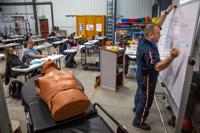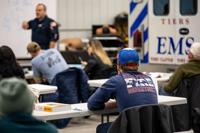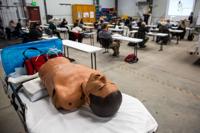CLAYTON — A flight paramedic with LifeNet had just inflated pig lungs during a lecture at the Thousand Islands Rescue Service headquarters Monday night, underscoring how critical in-person learning is for EMT students.
Many schools have adopted a hybrid style of learning balancing in-person and remote instruction. Many parents have simply decided to pull their children from in-person classes and have them learn remotely full time.
For what Pam A. Jones is doing, the idea of learning how to make snap decisions to help lives can hardly be done online. That’s why she fought for her spring 2021 EMT class to be done in person. Mrs. Jones, a coordinator and paramedic at the rescue service, was told organizing twice-weekly, near four-hour classes for six months while also in person would be extremely difficult.
“Difficult?” she asked. “I can do difficult.”

Kyle Williams, a flight nurse for LifeNet of New York, instructs the class of EMT students Monday evening at Thousand Islands Emergency Rescue Service in Clayton. Kara Dry/Watertown Daily Times
The roughly 20 students sat at their own tables spaced 6 feet apart. There’s a day care worker, a retired doctor, firefighters, high school students and college students. The classroom was in the rescue service garage, and students were flanked by two ambulances and several dummies on which to practice. They get temperature checks and don’t come to class if they’re feeling the slightest bit sick.
“The students are serious about having it in person,” she said, “so they don’t want to jeopardize it either.”
Over the course of the six-month class, the students will learn how the body works, and the signs it gives when it’s experiencing trauma. They’ll learn about the equipment on the ambulances and how to use it, or how to lead a crew. The flight paramedic who gave a lecture Monday showed the students how to use a bag valve mask — which helps people breathe in the field — by using the inflated pig lungs.
“He’s giving them a visual of how important this job is,” Mrs. Jones said Monday, “and that’s why we do it in person.” They’ll also learn about the decision-making process of calling for a patient to be airlifted. There’s a scale they use from one to 15. Alert and healthy people are at a 15, and the lowest someone can go is three, which is totally unresponsive. If a person hits a 13 on the scale — which is an altered state and determined if the patient doesn’t know who they are or where they are — the patient is airlifted, she said.

Kyle Williams, a flight nurse for LifeNet of New York, instructs a class of EMT students on airway physiology and proper emergency breathing treatments during a course Monday evening at Thousand Islands Emergency Rescue Service in Clayton. Kara Dry/Watertown Daily Times
Mrs. Jones likes to ask altered patients what day it is or the closest holiday. She’s never really liked asking who the president is since its divisiveness can upset patients. She remembers a recent incident where another paramedic asked who the president was and they said, “Hoover?”
A critical part of the class is the fact that so many young people are in it, and getting them involved early has been something of a specialization for Mrs. Jones. In 2018, she and another paramedic took a dozen girls to New York City to see a dispatch center and the 9-11 memorial.
They were all younger than 17 years old and part of junior class that would prepare them for EMT school. Now, seven are EMTs, another is in her class now, two are becoming a nurse, two physicians’ assistants, one a lawyer and another is pre-med in college.
“That’s not too shabby for Clayton, New York,” said Mrs. Jones, noting that a few were from LaFargeville and one from Alexandria Bay. “These are young people and that’s what’s exciting. The sooner we can get them inspired the better, and it happened because people that donate to TIERS decided that it was worth it.”
Mrs. Jones remembers how her training began years ago when she was a volunteer driver of an ambulance at TIERS. She had no training yet, but she remembers a call coming in about a woman in Clayton who wasn’t waking up. She knew the only ambulance in town was busy, so she raced over to the house to do what she could. She began CPR, which is all she knew how to do at that point, but the patient had died in her sleep.

Kyle Williams, a flight nurse for LifeNet of New York, instructs a class of EMT students on airway physiology and proper emergency breathing treatments during a course Monday evening at Thousand Islands Emergency Rescue Service in Clayton. Kara Dry/Watertown Daily Times
“I didn’t like the feeling of not knowing what to do — even though I did everything I was trained to do,” she said, “and even if I was a paramedic that day, I wouldn’t have been able to save her.”
She’s a reflection of her students as well — local people wanting to help their community.
“These are the people in our community getting up in the night coming to our fires and our calls and then getting up to their sometimes low-paying job,” she said. “In my experience, it’s not that these people want to be badass heroes. They are just good people who want to do good things for others in their community.”
"difficult" - Google News
February 10, 2021 at 10:01AM
https://ift.tt/3jD1OO2
'I can do difficult': Thousand Islands rescue paramedic works to ensure EMT class remains in-person - NNY360
"difficult" - Google News
https://ift.tt/2VWzYBO
https://ift.tt/3d5eskc
Bagikan Berita Ini














0 Response to "'I can do difficult': Thousand Islands rescue paramedic works to ensure EMT class remains in-person - NNY360"
Post a Comment